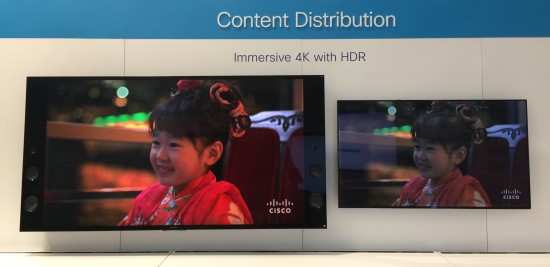I’ll make a bet. If you ask any of the leaders in broadcast television to sum up this year’s National Association of Broadcasters (NAB) convention in three words, they would say: IP, Virtualization, and HDR.
And that’s no surprise. Collectively, our entire video ecosystem is searching for ways to apply the same technological advances from IT to their services so they can support the massive shifts in video we all know too well: multi-screen viewing, binge viewing, immersive entertainment.
This year’s NAB Show was an especially exciting time for us, because we spent the last two years redesigning, from scratch, our full broadcast TV portfolio. The impetus, truth be told, was the emergence of 4K/UHD video, and its core enabler, HEVC compression. Essentially, it was one of those product design moments: Well, as long as we are making this shift, what can we do to bring in the other advancements in video delivery – like virtualization. Like IP-based distribution. Like the modularity that enables software-based appliances and cloud-based operations.

In short, we’ve overhauled the line so as to give our broadcast-side partners the mechanisms to drive service velocity, revenue growth, and technological adaptability. So, the 2016 NAB Show was a sort of coming out party for us, and in particular, for our new D9800 Network Transport Receiver, and supporting applications from our Virtualized Video Processing platform: the Virtual Digital Content Manager, and PowerVU Network Control system.
Here’s some background: When you put yourself in the shoes of someone tied to satellite-based distribution, things are different than if you’re accustomed to terrestrial and IP-based delivery. Very different. You’ve likely made multi-year, multi-million dollar arrangements to lease satellite transponders. And the more networks you operate, the more transponder space you need. Plus, you’re probably carrying the same show in at least two formats: Standard Definition/SD, and High Definition/HD.
Up until now, that meant leasing transponder space for all of it – SD and HD, no matter how duplicative. Take the case of one of our broadcast-side customers, who wanted to address this particular challenge by way of “transponder consolidation” – sending only the HD stream, at the uplink, and deriving both it and an SD version, at the downlink. Our analysis quickly showed that by moving to the D9800 and taking advantage of the multi-transport input, they could do just that – and save 40-50% on the capital expenditures associated with not having to buy duplicative transponder carriage.
But wait! There’s more…like the potential onslaught of 4K programming, which is four times larger than HD. That’s where HEVC comes in, to compress 4K content as much as possible, without degrading picture quality, before distributing it. This is where the Cisco Virtual DCM plays a role.
This all rolls up into the category of “virtualized primary distribution,” which is good because it lets broadcasters support new capabilities – like the HEVC they’ll need to convey 4K programs – in software, with the Virtual DCM. This also simplifies operations, by way of template-based workflows and RESTful APIs to related distribution components, like encryption and IRD management/control for event scheduling, blackout control and other use cases. And, perhaps more importantly, it positions broadcasters to evolve to new architectures, like IP distribution.
Similarly, the D9800 Network Transport Receiver was specifically and modularly designed to support multiple applications (decode, transcode, decrypt, de-multiplex), with full IRD control, template-based workflows, and an on-board and “pay as you grow” licensing, which can be activated when and as needed.
And here’s a little known fact from our demonstrations at NAB: We actually had our D9800 receiving and decoding High Dynamic Range (HDR) encoded 4K content. Something we are confident to say is an industry first. While the industry is still waiting to see how HDR standards are being implemented, we took the opportunity to highlight how one approach – Hybrid Log-Gamma (HLG) –provides backwards-compatible implementations of HDR for any resolution. This is a great benefit to our customers who want to feed a single HDR encoded stream to the satellite, and be able to distribute to both HDR and non-HDR compatible systems. And we had our D9800 showing just that: playing out pristine 4K/HDR content on a compatible screen with one D9800 decoder, while a second D9800 decoder played back the same stream to a regular 4K screen.
That’s why this NAB was very exciting for us. Whenever you can do things that help your customers grow and thrive – like supporting new functionalities and new transport stream types, while simplifying workflows for encryption and event scheduling (things they need!) that’s a very, very good thing.

CONNECT WITH US